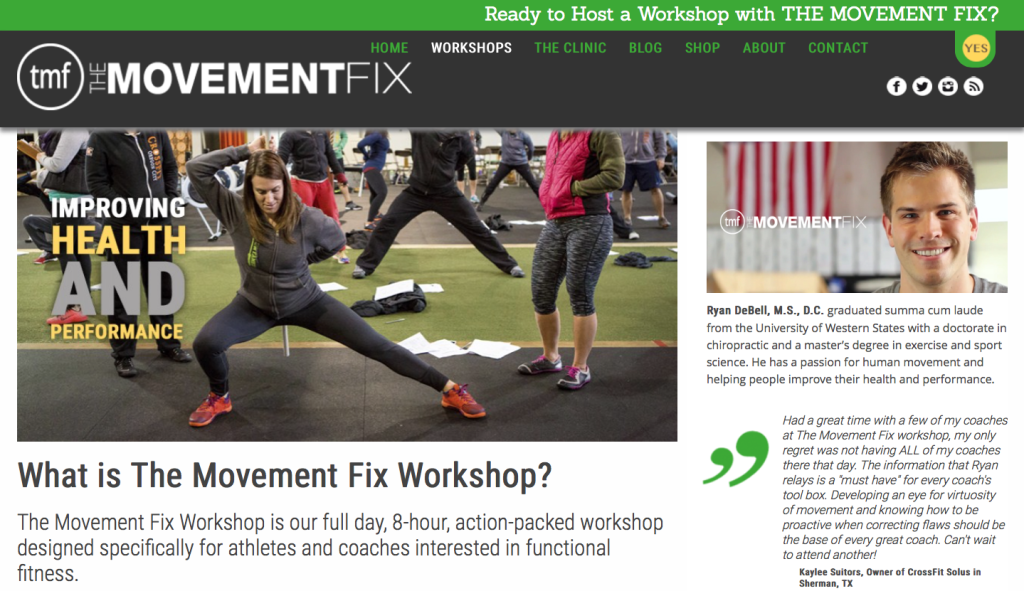
What I Learned at The Movement Fix Workshop
I recently attended Ryan DeBell’s Movement Fix workshop, which helps athletes improve their pulling, squat, and overhead mechanics. As a Fascial Stretch Therapist™ and flexibility coach I have spent a lot of time in gyms watching athletes prepare for their workouts (warming up and stretching).
During workouts I see a lot of athletes struggle to prevent rounding at the bottom of the squat and combat overextension of the low back during overhead lifts.
While many athletes are aware that they struggle with certain movement components (supporting the bar in the front rack position) – there is a disconnect between what they do and what is actually needed to correct the problem.
In other words, will stretching the hamstrings actually improve deadlift mechanics – so that athletes won’t have low back pain or stiffness after workouts? Ryan teaches athletes and coaches how to become ‘Movement Detectives’ so they can find the right exercises for the desired result.
Ryan’s workshop gives athletes focus and empowers coaches to quickly fix the central components behind dysfunctional movement patterns.
Here my 5 Take-Aways from the Workshop
#1: Spinal Stability is the Foundation
#2: Don’t Punish the Victim – Find the Criminal
#3: The Biggest Squat ‘Fix’ is Hip Anatomy
#4: Find the Minimum Effective Dose
#5: Strengthen the New Range
#1: Spinal Stability is the Foundation
Before stretching the shoulders or ‘punishing the hamstrings’ athletes need to assess their ability to keep a neutral spine during hip flexion and extension. If an athlete cannot keep the back flat against the floor during a leg lowering test or straight leg raise, the limiting factor in the deadlift is probably a core stability problem not a hip flexibility problem.
Dysfunctional breathing and abdominal weakness (poor anterior core stability) will limit both hip and shoulder flexion. A dying bug or RKC plank will do more for your chronic hamstring tightness than stretching.
#2: Don’t Punish the Victim – Find the Criminal
Ryan explained that it is a good idea to consider the “Question behind the question.” Instead of trying to find the ‘best’ hamstring stretch – ask yourself why your hamstrings are tight in the first place. If your hip-flexors are always tight, maybe your weak abdominals are forcing the psoas to take on additional work to stabilize the spine. Muscle tightness is often a protective mechanism that is the result of poor core stability. Athletes can save themselves a lot of time by first considering why an area may be tight or why range of motion is limited.
#3: The Biggest Squat ‘Fix’ is Hip Anatomy
Ryan’s blog post, “The Best Kept Secret: Why People HAVE to Squat Differently” is a game changer. Instead of accumulating hours trying to hip mobility – why not find the best squat stance for your own hip anatomy. The breakouts during the workshop for finding an ideal squat stance created INSTANT improvements in squat form. Athletes that find their ideal stance can then fine-tune their squat by looking at how much additional mobility they actually need in that position.
#4: Find the Minimum Effective Dose
One of the reasons many gym members ‘forget’ to stretch or do mobility work is that it hurts like hell! If pain signals the brain to ‘shut-down’ range of motion – why would athletes want to aggressively force themselves into positions they cannot comfortably maintain?
I discussed foam rolling with Ryan and we both agreed that the primary benefit is decreasing neural tension – not breaking apart tissue. Foam rolling is not myofascial release – but can help athletes reduce tension and get into better positions. Foam rolling should be brief and no more than four out of ten on the pain scale. Athletes will then have more time for position specific mobilizations in the gym.
As a Structural Integrator I am always reminded of Ida Rolf’s concept, “Less is More.” Studying with Stretch-to-Win® I learned that effective stretching consists of gentle traction, progressive range of motion, and neurological reflexes that release tension. Ryan’s suggestions mirrored these views, emphasizing the role of the nervous system in maximizing range of motion. Muscles are stupid – if you want to PR your deadlift – train the brain to support position specific mobility and then find stability through the new range.
#5: Strengthen the New Range
One of the biggest take-aways was the following idea, “If you gain mobility, you need to OWN it.” Athletes tend to separate the practice of stretching, rolling, and myofascial release from the very reason they are doing them in the first place. Ryan provided great assessments for the core stability and flexibility needed for the deadlift before showing a great progression that allowed athletes to strengthen the position in a progressive range of motion.
If an athlete improves their ability to resist lumbar hyperextension and demonstrate good hip flexion – but is still not ready to pull off the floor – why not strength the new range while maintaining good position?
On the other hand – why do a joint-mobilization or spend time stretching if you are not going to use that new range? Ryan showed some great exercises to reinforce the changes in mobility than athletes experienced.
As a flexibility and movement coach I enjoyed seeing Ryan integrate the collective wisdom of DNS, Stuart McGill, Charlie Weingroff, and many others into his own unique system of movement mechanics.
Most of the time athletes and coaches walk away from workshops with dozens of drills they don’t have time to implement and more information than they need – instead Ryan delivered a ‘Less is More’ approach that stunned us all with it’s simplicity and effectiveness.” – Kevin Kula, “The Flexibility Coach”, Creator of FlexibilityRx™
Tags: flexibility training, joint by joint approach, mobility seminar, Ryan Debell, The Movement Fix

Leave A Reply (No comments so far)
You must be logged in to post a comment.
No comments yet